Have you ever wondered what the energy body is? And what colors of the chakras and their meanings are?
Well, no need to wonder anymore!
This blog post is going to clear up all of the colors of the chakras and the energies they signify for you.
Perhaps you have heard about the seven chakra model and its seven colors of the chakras. Each chakra corresponds with a color, attribute, seed sound and meaning.
Is there only one chakra model? And how did our understanding of the chakras evolve from ancient times to our contemporary seven chakra model?
Let’s dive into this fascinating topic!
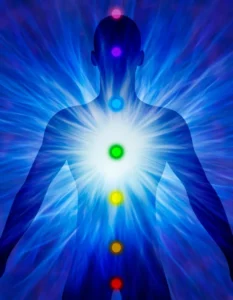
We are not just a physical body!
In yoga, we acknowledge that we are not just a composite of bones, muscles, organs, and nerves but we have five distinct layers known as the koshas. These are the physical human body layer (annamaya kosha), the breath or energy body (pranamaya kosha), the mental body (manomaya kosha), the wisdom body (vidyamaya kosha), and the bliss body (anandamaya kosha).
Each layer has its own qualities and functions. The physical body is dense and gross, by comparison the mental body is more subtle and refined.
The koshas work together to create our experience of reality. In addition, they provide a map for our journey of self-discovery. Therefore, by exploring each layer, we can gain a deeper understanding of who we are and how we relate to the world around us. Ultimately, this understanding can lead to greater peace and satisfaction in life.
Below we will explore the anatomy of the energy body. We will also and look into the meanings, chakra colors, and ideas for balancing chakras through the use of yoga tools.
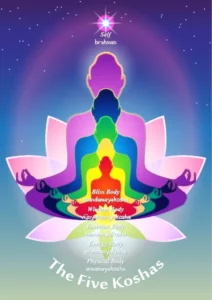
What is the energy body in yoga and what does it do?
The energy body is a key component of yoga practice. The Sushumna Nadi, or central channel, runs from the base of the spine to the crown of the head. Prana, or life force energy, flows through this channel. Ida and Pingala are the two secondary channels that crisscross the Sushumna Nadi. Prana also flows through these channels, but in a more subtle way.
Through yoga practice, we can begin to unify the flow of prana through all three channels. This unification gives rise to a more balanced and harmonious state of being. When the energy body is in balance, we experience greater health, well-being, and inner peace.
What does the word “chakra” mean and where does it come from?
The word chakra means “wheel” and is currently understood as a “center of spiritual energy” or the “wheels of life”.
References to the chakras date back to the Upanishads, roughly 600 BCE. The Chakra systems evolved and became more widespread throughout the time period of Tantra, from 850 CE – 10th century.
Chakras are focal points for meditation inside the human body, visualized as energy, rather than fixed psychic organs in set locations. As such, Sanskrit Scholar, Christopher Wallis, relates that they are highly mutable and fluid, rather than set and static.
The Chakras are structures of human consciousness that are experienced through meditations, visualizations, sound, vibration, and felt sense experiences. Looking back through ancient source texts you will find many varied Chakra systems some with seven chakras and others with more or less.
Today the most commonly discussed chakra system in the West has been adapted and morphed from the ancient source teachings. It is described with seven main energy centers that lie at the junction points of the Ida, Pingala, and Sushumna Nadis and layered with associations of colors, elements, seed sounds, and psycho-emotional patterns. While no exact teaching like this is found in the ancient texts, the study and meditation of this seven chakra system provide us with a very relatable framework for healing both physically and mentally that is well received by western yogis.
The energy body is also home to the colors of the chakras, or energy centers.
The most popular chakra system explored in Yoga today is comprised of seven major energy. Specific energy centers, located along the Sushumna Nadi, govern different areas of the human body and our physical health. Each specific energy center influences different characteristics of our psycho-emotional makeup and mental well-being and is associated with a different color, seed sound, and element.
When all of the chakras are in alignment, and the colors of the chakras can shine brightly they create a harmonious flow of energy throughout the body. However, when one or more of the chakras are out of balance, it can lead to physical, emotional, or mental health problems.
Colors of the Chakras
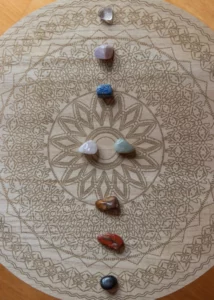
The seven colors of the chakras are:
Root Chakra(Sanskrit Word or Name: Muladhara Chakra): color red
Sacral Chakra (Sanskrit Word or Name: Svadhisthana Chakra): color orange
Solar Plexus Chakra (Sanskrit Word or Name: Manipura Chakra): color yellow
Heart Chakra (Sanskrit Word or Name: Anahata Chakra): color green or pink
Throat Chakra (Sanskrit Word or Name: Vishuddha Chakra): dark blue color
Third Eye Chakra (Sanskrit Word or Name: Ajna Chakra): color indigo
Crown Chakra (Sanskrit Name: Sahasrara Chakra): color violet or white
What do the Seven Colors of the Chakras represent?
· Root Chakra
The first chakra is located at the base of the spine. The color red and governs our survival instinct, security, and sense of belonging.
· Sacral Chakra
The second chakra is located just below the navel. The color is orange and governs our creativity, sexuality, and sense of pleasure.
· Solar Plexus Chakra
The third chakra is located in the upper abdomen, just above the belly button. The color of the chakra is yellow and governs our personal power, self-esteem, and sense of purpose.
· Heart Chakra
The fourth chakra is located in the center of the chest. The color is rose quartz or emerald green and governs our ability to love, feel compassion, and experience joy.
· Throat Chakra
The fifth chakra is located in the throat area. The color is blue and governs our ability to communicate clearly and express our truth.
· Third Eye Chakra
The sixth chakra is located between the eyebrows. The color of this chakra is indigo and governs our intuition, imagination, and psychic abilities.
· Crown Chakra
The seventh chakra is located at the top of the head. The color of this chakra is crystal white. It governs our connection to Spirit, higher wisdom, and our sense of unity with all that is.
What are the psycho-spiritual aspects of each of the colors of the chakras?
Muladhara Chakra
The first chakra at our root attends to our core survival needs of food, water, safety, home, and the ability to function in life. Additionally, when the first chakra is balanced you may feel grounded, still, secure, and have the ability to maintain a presence throughout daily life activity. Visualize here the root chakra color earthy red, like dense thick molten lava. Meanwhile when the root chakra is in excess there is heaviness, sluggishness, resistance to change, a tendency to overeat, material hoarding, greed, aches and pain in legs, feet, and bones, and the tendency to overwork. With a deficient root chakra, there is a tendency toward fear, anxiety, resistance to structure, spaciness, anorexia, underweight, vagueness, lack of body awareness, and difficulty in manifesting.
Svadhistana Chakra
Svadhisthana attends to our sexuality, creativity, and pleasure. The energy center location governs the female reproductive organs and the watery element of the hips and low belly. When balanced we are able to go with the flow, embrace change, and nurture ourselves and others. As such, possess a healthy relationship with enjoyment and pleasure, are satisfied in our sexual lives, and find healthy creative outlets to enhance our lives. When in excess we are prone to excessive mood swings, poor boundaries in relationships, addiction to stimulation, sexual addictions, and emotional dependence. When we have a blocked sacral chakra we become rigid, lack desire, passion or excitement, avoid pleasure, create excessive boundaries, and experience menstrual difficulties and reproductive issues.
Manipura Chakra
Our solar plexus chakra, manipura, governs our self-esteem and ability to find right-livelihood. This energy center, located in the core of our body, governs the subtle energies which help us develop a strong self-concept. Visualize the solar plexus chakra as a yellow color, a yellow as bright and powerful as the sun. With a balanced third chakra chakra, we are responsible and reliable, we possess healthy self-esteem, and have a clear direction in life. When the third chakra is inn excess contributes to dominating, blaming, aggressive, and/or cutthroat behavior. We may become constantly active, possess the tendency to get in the last word, or find ourselves becoming judgmental, and irritable with violent outbursts and/or anger. When deficient we experience low energy, low self-esteem, poor digestion, victim consciousness, lethargy, and/or chronic fatigue.
Anahata Chakra
The lower three chakras help us relate to manifestation in the world of Prakriti (manifest world); the upper three chakras are about connecting to our higher faculties. The heart center, Anahata, is the bridge and its purpose is to balance our ability to be functional as embodied beings and fully present in our spiritual quest. When in balance Anahata governs over our abilities for love, compassion, empathy, and loving-kindness towards ourselves and others. When excessive, issues such as co-dependence, jealousy, acting out as a martyr or overworking to please others may present. Physically one may find hypertension, heart disease, circulatory problems, and difficulty breathing. When Anahata is out of balance, we may see behaviors that are anti-social such as being withdrawn, lonely, isolationism, and a lack of empathy and/or fear of intimacy.
Vishuddha Chakra
Vishuddha, our third eye chakra, governs our communication, purification, and refinement. Visualize here the throat chakra color of blue lace agate which is so pure and refined. When in balance one is a good listener, has clear communication, a resonant voice, and the ability to speak and offer to the world their unique gifts. In balance, the qualities of harmony, resonance, coherence, self-expression, and truth manifest naturally. When in excess, one may talk too much, talk too loudly, or the mind may feel unable to organize itself. When we have a blocked throat chakra you may have a fear of speaking, a small weak voice, difficulty putting thoughts into words, shyness, and/or a quiet constricted voice.
Ajna Chakra
Ajna presides over our ability to connect to the higher faculty of the vijnanamayakosha where insight, wisdom, and intuition reside. Visualize the third eye chakra in a brilliant, clear, amethyst indigo color. When in balance one has a quiet and centered mind, the strong ability to use their imagination, rely on their intuition appropriately, and can use visualization and practice pratyahara. When deficient there is insensitivity, poor vision, poor memory, difficulty with visualizations, inability to remember dreams, and/or denial (can’t see what’s going on). In excess, one might have hallucinations, obsessions, delusions, difficulty concentrating, and nightmares.
Sahasrara Chakra
Sahasrara is the chakra that provides a spiritual connection and enhances our relationship to the Divine. When balanced one has awareness of the Unity that connects all things, is active on the path of enlightenment, and is open to the support of grace and moments of bliss revealed in daily life. Some systems visualize the crown chakra color as violet and others as crystal white. When in excess one becomes out of touch with their body, may experience dissociation, present as overly intellectual, possess a spiritual addiction, or be spacey. When deficient one may become too materialistic, possess learning difficulties, feel alienated from the true self, get fixated on one idea, and/or find boredom or apathy in life.
What are the seed sounds of the chakras?
Chanting the seed sounds is one effective and powerful practice for chakra healing and rebalancing. Each seed sound is associated with a specific chakra. The seed sounds are:
Root Chakra – Lam
Sacral Chakra – Vam
Solar Plexus Chakra – Ram
Heart Chakra – Yam
Throat Chakra – Ham
Third Eye Chakra – Aum (or Om)
Crown Chakra – Silence
When we chant these seed sounds, we bring attention and focus to each chakra in turn. By doing so, we can help to heal and rebalance any issues that may be going on in that particular chakra. The seed sounds are also a way of connecting with the energies of each chakra and can help to bring about a sense of calm and well-being.
What is the vibration of the seed sounds?
Each seed sound has its own unique vibration that resonates with the energy of its associated chakra. When we chant the seed sounds, we are essentially setting up a vibrational resonance within our own energy system. This can help to break up any blockages or imbalances that may be present and allow for a freer flow of energy throughout the system.
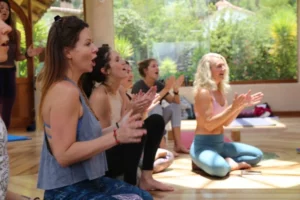
Can seed sounds really heal?
There is no definitive answer to this question, as each person’s experience will be unique. However, there is plenty of anecdotal evidence to suggest that seed sounds can indeed be helpful in healing
Lam
Lam is associated with the root chakra, which is located at the base of the spine. The seed sound of the root chakra helps to ground and stabilize us.
Vam
Vam is associated with the sacral chakra, which is located in the lower abdomen. The seed sound of the sacral chakra helps to increase our creativity and sexual energy.
Ram
Ram is associated with the solar plexus chakra, which is located in the upper abdomen. The seed sound of the solar plexus chakra helps to increase our self-confidence and personal power.
Yam
Yam is associated with the heart chakra, which is located in the center of the chest. The seed sound of the heart chakra helps to open our hearts and promote feelings of love and compassion.
Ham
Ham is associated with the throat chakra, which is located in the throat area. The seed sound of the throat chakra helps to improve our communication and expression.
Om
Om is the sound with an association to the third eye chakra, which is located between the eyebrows and towards the center part of the brain. The seed sound of the third eye chakra helps to connect us to our intuitive awareness and ability to witness the fluctuations of the mind without attachments or aversions.
Silence
Post-vibrational silence after the chant has an association with the crown chakra, which is located at the top of the head. The seed sound of the crown chakra helps to connect us with our higher selves and the Divine.
What elements have an association with the colors of the chakras?
The first chakra, the root chakra, has an association withthe earth.
The second chakra, the sacral chakra, has an association with water.
The third chakra, the solar plexus chakra, has an association with fire.
The fourth chakra, the heart chakra, has an association with air.
The fifth chakra, the throat chakra, has an association with ether.
The sixth chakra, the third eye chakra, has an association with light.
The seventh chakra, the crown chakra, has an association with consciousness.
Each of these elements has qualities and energies that we can invoke to help us balance excess and deficiency an important role in helping us work with uncomfortable physical symptoms, emotional challenges, and our spiritual development.
By understanding and working with these elements, we can begin to balance our chakras and achieve greater harmony in our lives.
How can yoga help me balance my chakras?
There are a variety of yoga practices that can help to balance the chakras. Using targeted and specific asana (yoga poses), pranayama (breath work), we can unblock stuck energy and promote balance.
Meditation also helps to quiet the mind and guided visualizations help us to bring awareness to the body’s energy centers. Other yoga tools from our toolbox such as using affirmations, chanting seed sounds that bring vibration to certain areas of the body, using mudras, or hand gestures, can also help aid the flow of energy through the chakras.
Visualizing the colors and the corresponding chakra in meditation and yoga asana practice can help us bring prana “life force” healing energy into these areas. Combining seed sounds while invoking the qualities of the elements can help us practice with unique self-expression that supports our health and vitality.
By practicing yoga regularly, you can help keep all the colors of your chakras bright and in balance and promote overall health and well-being.
How can I learn more?
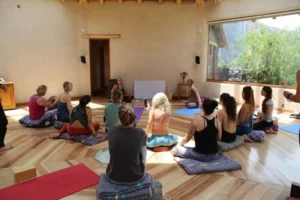
If you have interest in learning more about the colors of the chakras, yoga, or the energy body, yoga teacher training is a great way to dive deeper into the practice. You will not only learn about all the chakras and their associated chakra colors but also use tools from your yoga toolbox that promote energy healing.
At the Soma Yoga Institute, we offer an immersive 200-hour yoga teacher training that covers all the basics of yoga philosophy, anatomy, and teaching techniques. We also offer this program online.
During teacher training, you will participate in chakra-focused yoga asana classes, guided chakra meditations, and deep relaxations designed to bring awareness to the seven chakra colors and rebalance your entire being. You’ll also learn about the chakra system and how to use yoga to balance the energy centers in your body.
Upon completion of the training, you’ll be ready to lead your own yoga classes with confidence.
If you’re ready to take your yoga practice to the next level, contact us today to learn more about our yoga teacher training program.
We can’t wait to help you on your journey!